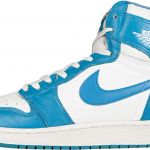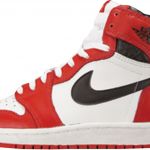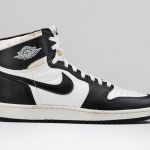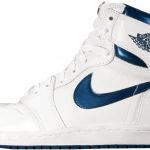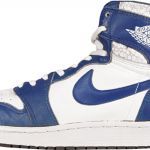
5 things you probably didn't know about the Air Jordan 1
Contains: Stefanel Trieste, a "deception" and the number 13
May 2nd, 2019
Let's start by saying that it's not all clear from the beginning.
Michael Jordan did not want to sign with Nike, he wanted adidas. It was the entrepreneurial spirit, the brazenness and the vision of an Italian-American that changed forever the perception and evolution of the sneaker world and beyond: Sonny Vaccaro.
At college, Michael wore Converse and those are the shoes that the number 23 had on his feet when he put the shot that gave the title to North Carolina against Georgetown in 1982.
Jordan didn't really like those shoes - "they look like the devil's shoes" - and it seems that the soles were too high and he couldn't "feel" the field under his feet. That was the keystone of everything: Nike and Air Jordan 1 designer Peter Moore (Nike's Creative Director) reduced that excessively high sole too, received some guidelines from Michael himself and made a "different and exciting" shoe that changed forever Nike and the sneaker culture in general.
We have therefore decided to put together 5 things you probably didn't know about the Air Jordan 1.
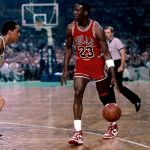
ALSO LOOK:
10 things you probably didn't know about the Swoosh
5 things you probably didn't know about the Adidas logo
1. "The deception" of the Nike Air Ship
The Air Jordan 1 was officially released in April 1985 and how is it possible then that the letter that the NBA sent to Nike to prohibit Michael from wearing those black and red shoes refers to a game played by the Bulls and then by Jordan on October 18th, 1984? The answer is simple but not obvious: Michael Jordan at the beginning of his rookie year ('84 / '85) wore the Air Jordan 1 prototype: the Nike Air Ship in the famous "Banned" colorway (Red and Black) during a pre-season match against the New York Knicks. The Air Ship was extremely similar to the Air Jordan 1 - from that silhouette, in fact, Peter Moore made the first Air Jordan. Nike chose to let Jordan wear the Air Ship until April 1985 - in the colorway white/red because of the "uniformity of uniform" rule - driven by the unofficial call of the NBA commissioner David Stern as the colors of the shoes had to mirror those of the uniform and those of the shoes of teammates - because no one would have noticed the difference and exploited the "Banned" question to build perhaps the most captivating advertising campaign ever. The TBWA / Chiat / Day advertising agency created the spot that is still a cult among sneaker enthusiasts.
The shoes sold out in no time, they cost $65 but some retailers chose to earn a few dollars more by placing them at 100, something that was unprecedented in the sneaker world of the time. Michael donned the "Banned" Air Ships again during the All-Star Game's Slam Dunk Contest in February 1985 but since there was not an official game, the NBA did not find the Bulls but took the opportunity to send the famous letter for "discouraging" the use of that shoe with the "colors of the devil" as Jordan himself said.
In a 1986 interview with David Letterman, Michael responded to David's joke that the shoes had been banned because they were ugly, "I agree with you, they are ugly". That's Michael, baby!
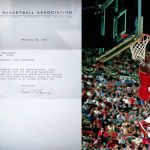
2. The Air Jordan 1 KO
In 1986 Nike began producing a version of the Air Jordan 1 in canvas. To date there are no official versions of what the "K.O." meant but in reality the answer we like the most is the following: at the time Nike was not the largest sportswear company in the world as we know it today, but rather it had staked everything on the Michael Jordan bet and could not know if it was the best idea ever or a giant flop that would have caused Beaverton's company to sink due to the huge investment made on the Brooklyn native player - the story told us that things went rather well - the Air Jordan 1 KO version was a very smart move by Nike. The shoes were in canvas - more comfortable, resistant and breathable material than leather - basketball was born on the street and that performance shoe was a huge success. So Nike was able to take advantage of the Air Jordan 1 molds and earn a lot of extra money that they managed not to knock out the company (most of them think that KO stands for "knockout" or "Knock-Off" ), but why ruining a good story with the truth.
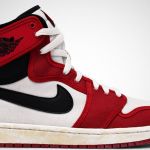
3. Italian history behind the Shattered Backboard
In the summer of 1985 during a mini promotional tour organized by Nike in Italy, Michael Jordan, barely twenty-two (rookie of the year in the previous season) found himself playing a friendly match between Stefanel Trieste and JuveCaserta, at the time sponsored by Mobilgirgi, at the PalaChiarbola in Trieste, it was August 25th. Originally Michael would have had to play with Stefanel Trieste once and the other with Mobilgirgi Caserta but after supporting the pre-set warm-up he decided he would play the whole game with the black and orange tank of the Trieste team and with his Air at the foot Jordan 1 "Chicago".

Jordan played a superstar game by putting 30 points on the scoresheet with games from the beginning, but the one that remained in the story and gave its name to one of the most beautiful and sought-after Air Jordan 1 colorways is when detaching shortly after the free throw line, he nailed a clamorous dunk that shattered the backboard at the time not yet in plexiglass but in glass.
Giancarlo Sarti, General Manager of Mobilgirgi Caserta in 1985 tells that under the shattered basket Pietro Generali and Toto Lopez remained shocked that Jordan had not been touched by the glass pieces that had fallen on him all over the body and that caused a laceration of the tendons of the hand. The JuveCaserta's coach was the legendary Bogdan "Boscia" Tanjević who recounts that after seeing Jordan crush the detachment shortly after the bezel and smash everything, he threw down 7 grappas getting drunk "like a beast", to use the words of the Italian coach -Montenegrin.
The colorway Shattered Backboard recalls the colors of that special Stefanel Trieste tank top and recalls an all-Italian basketball moment.
4. The colorways produced between 1985 and 1986 are 13
Not really a lucky number if you think about it, but leaving aside the superstitious issues, the success of the Air Jordan 1 was devastating. There is no way to determine exactly how many Air Jordan 1 models came out (high, mid, low, women's, etc.) but we can say with certainty that between 1985 and 1986, or in the first year since official release, 13 colorways were produced which I would call OG, here they are:
5. The Air Jordan 1 "UNRELEASED"
During Jordan's second season in the NBA ('85 / '86) Michael continued to wear the Jordan 1 but on October 25th, 1985, after only three regular season games, in the challenge against the Golden State Warriors, he fractured the navicular bone of Tarsus of the left foot. Michael lost 64 games of that season, returned in March and Nike "equipped" him with an unreleased Air Jordan 1 pair with ankle support straps. Thanks to the return to the field on the 23rd, the Bulls won the last 16 games of the regular season and qualified for the playoffs where they found Larry Bird's Boston Celtics in the first round. The Chicago Bulls lost that 3-0 series (at the time the first round was still the best of 5 games) but in game 2 (April 20, 1986) Michael put 63 points on the scoresheet - best performance ever in the playoffs - at Boston Garden and in the after game Larry uttered the famous phrase "I think it's just God disguised as Michael Jordan".

















































